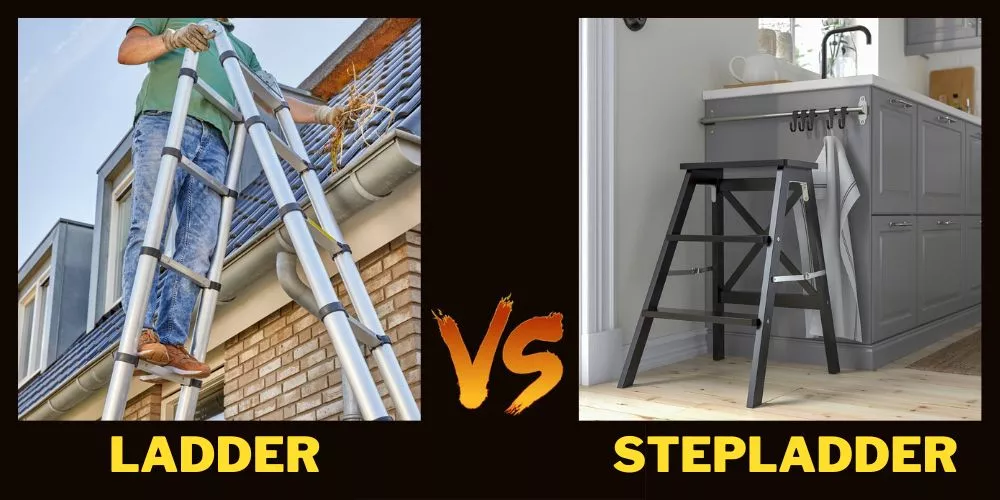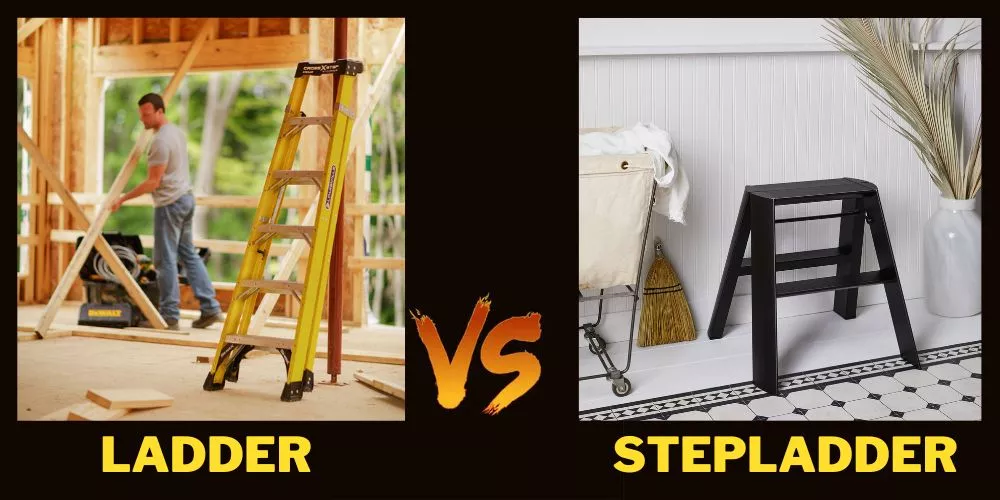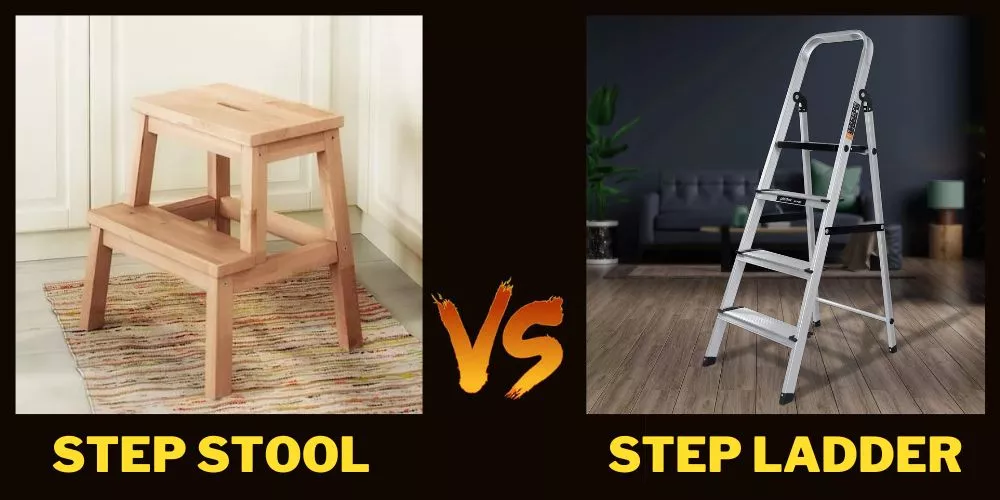Choosing the right equipment for height-related tasks is crucial, whether you’re a DIY enthusiast, a construction worker, or simply trying to reach a top shelf.
This article will delve into a comprehensive comparison of two commonly used climbing tools: ladder vs stepladder.
We’ll examine their structure, safety features, usability, and suitability for different tasks, helping you make an informed decision.

Join us as we climb to new heights in our knowledge on ‘Ladder vs Stepladder’.
ladder vs stepladder: What Are the differences?
In understanding the difference between ladders and stepladders, it’s helpful to understand their definitions, compare their structures, safety features, usability, and look at the different tasks they’re suitable for.

🪜Definition
- Ladders: A ladder is generally a straight, elongated equipment with two long vertical supports connected by rungs or steps. It requires firm support, like a wall, to lean against for balance.
- Stepladders: A stepladder is a self-supporting structure with an A-frame design. It has steps on one side and usually a platform at the top for support when working.
🪜Structure
- Ladders: Ladders are designed with a straight structure which makes them taller and capable of reaching higher heights. They often come with rungs on one side only.
- Stepladders: Stepladders have an A-frame design which makes them sturdier and freestanding. They typically have steps on both sides (often with one side labeled as not for climbing) and often include a small platform on top.
🪜Safety Features
- Ladders: Ladders typically require sturdy support to prevent toppling over, which can be a disadvantage. However, some ladders come with rubberized feet designed to prevent slipping.
- Stepladders: Stepladders are more stable due to their A-frame design, but the user needs to stay centered between the rails to avoid tipping over. Most stepladders also come with anti-slip rubber feet for additional safety.
🪜Usability
- Ladders: Ladders tend to be longer, which makes their transport and storage a bit more challenging. They are especially useful for tasks such as gutter cleaning, tree pruning, or reaching high shelves.
- Stepladders: Stepladders, being shorter, are typically easier to transport. Plus, their self-supporting structure makes them perfect for tasks that are located away from a support, like painting, replacing light bulbs, and various indoor chores.
🪜Suitability for Tasks
- Ladders: Given their reach, extension ladders are better suited for outdoor tasks, reaching high walls or ceilings, and roofing jobs.
- Stepladders: Step Ladders are ideal for medium height tasks, especially in indoor environments or where there’s no proper support for leaning a ladder like in the middle of a room.
In conclusion, while ladders and stepladders can serve similar roles, their distinct characteristics make them better suited for different tasks. Consider your specific requirements regarding height, stability, and portability when choosing between a ladder and a stepladder.
🪜Other Notable Differences
Definitely, there are a few additional aspects that can differentiate a ladder and a stepladder:
- Material: Both ladders and stepladders can be made from a range of materials, including wood, fiberglass, and aluminum. The choice of material can impact the weight, durability, and electrical conductivity of the item.
- Weight Capacity: Ladders and stepladders come with different weight ratings, which are assigned by the manufacturer based on the maximum weight they can safely support.
- Cost: Generally, the cost of ladders varies depending on their length, material, and type. Stepladders, due to their structure and additional features like platforms and tool trays, might sometimes be slightly more expensive compared to straight ladders of the same height.
- Ease of Setup: In most cases, a ladder requires leaning against a sturdy support to be safe for climbing whereas a stepladder is self-supporting and can be easily opened and placed on a flat surface.
- Maintenance: Depending on the material, maintenance requirements may vary. For instance, wooden ladders need to be kept dry to avoid rot, while metal ladders require checks for rust.
So, while the basic differences lie in their structure and usage, these additional factors should also be considered when deciding between a ladder and a stepladder.
Ladder vs Stepladder: Which type of ladder is best for home use?
Choose your ladder based on the specific needs of your home. For most light to medium-duty tasks around your household, a stepladder is often the most practical choice.
- Stepladders: Tend to be more convenient for home use due to their compact size, easier storage, and self-supporting structures. They work well for indoor tasks like changing light bulbs, reaching high shelves, and basic decorating or cleaning tasks.
- Ladders: They can be a good choice for outdoor tasks or situations where you need to reach significant heights, like cleaning gutters or painting in high places. However, they typically require more storage space and might be harder to maneuver in tight indoor spaces.
The Little Giant 22-Foot Velocity Multi-Use Ladder is often recommended as an excellent option for its versatility. It can be used as a regular ladder or transformed into an A-frame ladder, staircase ladder, extension ladder or even set-up on uneven surfaces, which covers a broad range of home use scenarios.
But if you are looking for something smaller and more lightweight, the Rubbermaid RM-3W Folding 3-Step Steel Frame Stool might be more appropriate. It’s compact, sturdy, and easy to store when not in use — great for less demanding tasks around the home.
Always remember to consider safety, storage space, and the specific tasks you’ll be doing before choosing between a ladder and stepladder for home use.
Conclusion:
Whether you choose a ladder or a stepladder largely depends on your specific needs and tasks. Opt for a ladder when higher reach and greater flexibility for outdoor tasks are required, and a stepladder when a self-supporting, compact solution for lighter tasks is desired.
Ultimately, understanding the differences between ladders and stepladders will help you make an informed choice, ensuring both safety and efficiency for all your height-related endeavors.


